26 of the best Mexican Street Foods
In every place, we visit we look for street food and as food tourism junkies Mexico was absolutely one of the best places to find a huge variety of famous Mexican street foods. We have found a lot of variations in Mexican Street foods depending on where you are in the country. Popular Mexican food as thought of by most North American tourists consists of tacos, tamales, gorditas, salsa and nachos (which are not Mexican by the way). Oh and by the way Mexico is in North America not Latin America.
On the Yucatan Peninsula street food was going to be very different from the standard Mexican street food. It naturally involved many of the same Mexican dishes that we have come to love, but it is a very different food culture and its influences are strongly European.
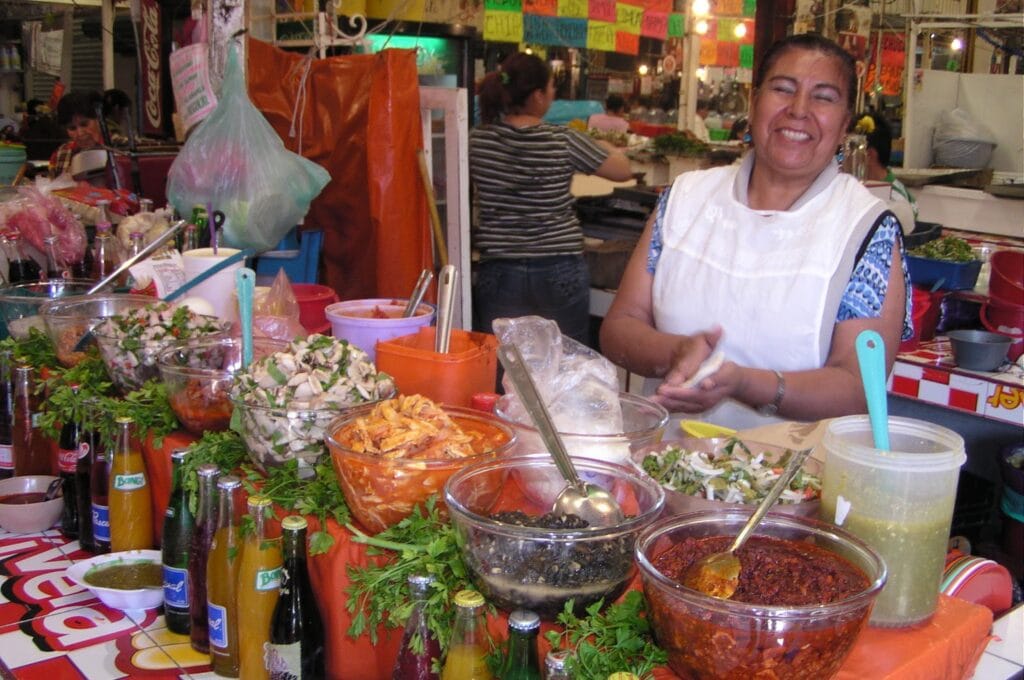
- 26 of the best Mexican Street Foods
- 7 Culinary regions of Mexico
- Difference between corn and flour tortillas across Mexico
- 26 Mexican Street Foods to try
- Cochinita Pibil
- Coconut – cocos frios, cremitas de coco, bolis de coco
- Pay de Coco
- Cremitas de Cocos
- Coco Frios
- Bolitos de Coco con Camote
- Raspados
- Paletas
- Marquesitas
- Merenque
- Kibis
- Panuchos
- Quesadilla
- Salbutes
- Tostada
- Elotes
- Esquites
- Tamales
- Gordita and sopas
- Tacos
- Torta Cubana
- Cemitas, Tortas, Empalme and Pambazos
- Tlacoyos
7 Culinary regions of Mexico
Traditional Mexican food varies a lot from region to region. The Northern region’s culinary heritage is based upon ranching which means a lot of grilled meats including, machaca, arrachera, and cabrito ranging from beef to goat. This food culture also has amazing cheese production from queso frescos to varieties of smoked cheeses. In the northern region flour tortillas are used more often because the territory was more suited to growing wheat for flour.
The food of the Yucatán peninsula is distinct from the rest of the country and is based on Mayan food with influences from Cuba and other Caribbean islands, Europe, Asia and Middle Eastern cultures. Corn is the basic staple and is used in both drinks and food and the most popular Mexican street food here is Conchinita Pibil.

Oaxaca’s indigenous cooking is known for its moles which include Negro (black), Amarillo (yellow), Coloradito (little red), Mancha Manteles (table cloth stainer), Chichilo (smoky stew), Rojo (red), and Verde (green). Chocolate is another important ingredient and is frequently hand ground and combined with almonds, cinnamon and other ingredients and added to moles or used in drinks.
In the Bajio region which includes Michoacan, one of the best-known dishes from the state is morisquesta – a sausage and rice dish along with carnitas, or deep-fried pork. The culinary treats include desserts like cajeta (goat’s milk caramel), chongos (curds in syrup), Arroz con Leche (rice pudding) and bunuelos (fritters). The town of Cotija is the birthplace of the famous Cotija cheese named after it.

Along the Pacific shoreline, you will find dishes like chilorio, birria, pozole, chilayo, menudo and pork dishes. Guadalajara is the region’s gastronomic centre, and the area’s most famous dish is birria, a stew of beef, mutton or pork with chilli peppers and spices.
The Gulf of Mexico is a mix of Indigenous, Spanish, Afro-Cuban, Caribbean, and creole food cultures. The Mayans contributed ingredients like corn, chocolate and vanilla and the region grows a wide variety of tropical fruits such as zapote, papaya, mamey, sour orange, and limes.

Mexico City is a melting pot of local ingredients, Mayan culture, and European cultures. The street foods of Mexico in the city include everything from barbacoa to moles, carnitas, tortas and insects. Mexico City is also where you will find some truly inventive new Chefs incorporating Mexican ingredients into new culinary adventures.
Difference between corn and flour tortillas across Mexico
Corn dough and flour dough tortillas are two popular types of tortillas used in Mexican cuisine. The main difference between these two types lies in the ingredients used to make the dough. Corn dough tortillas are made from masa harina, which is a type of flour made from dried corn kernels that have been soaked in an alkaline solution (such as lime water) and then ground.
This process is known as nixtamalization and it enhances the nutritional value and flavor of the corn. On the other hand, flour dough tortillas are made from wheat flour, which gives them a softer and chewier texture compared to corn tortillas. They also have a milder flavor that goes well with a variety of fillings. Additionally, flour dough tortillas are more versatile and can be used to make dishes such as burritos and quesadillas, while corn dough tortillas are primarily used for tacos and enchiladas. Overall, the choice between corn dough and flour dough tortillas depends on personal preference and the specific dish being prepared.
Our adventures included searching for the best street food and Mexican dishes we could find. The Santa Lucia Parque area is the best in town for authentic Mexican cuisine in the Yucatan alongside the newer innovative Mexican restaurants. However, just wandering around any area in any village of town in Mexico will result in you finding some fantastic refreshing Mexican drinks or refrescos and Mexican street foods.

26 Mexican Street Foods to try
Mexican street food is renowned for its vibrant flavors and diverse options. From tacos to tamales, these culinary delights have become a staple of Mexican culture. One popular street food is elote, which is a grilled corn on the cob smothered in a mixture of mayonnaise, cheese, chili powder, and lime juice. The combination of sweet, tangy, and spicy flavors creates a tantalizing sensation that keeps people coming back for more.
Another street food favorite is the iconic taco. With a variety of fillings to choose from, such as al pastor (marinated pork) or carne asada (grilled beef), tacos are a go-to option for locals and tourists alike. Additionally, quesadillas, gorditas, and tamales can be found in almost every corner of Mexico. These handheld delights are made with corn masa and filled with a plethora of ingredients like cheese, beans, or meat. Whether enjoyed on a busy street corner or at a bustling market, Mexican street food offers an authentic culinary experience that captivates taste buds and reflects the rich tapestry of Mexican cuisine.
Cochinita Pibil
Served everywhere in the Yucatan cochinita Pibil from the finest of gourmet restaurants to simple street stalls. The national dish Cochinita Pibil is pit-cooked pork that has been marinated overnight in a naranja agria (sour orange) and annatto-based marinade.
Initially devised as a way to preserve meat in the tropical climate, Pibil has become the region’s most famous dish. A Mayan word that means to bury, or to cook underground, Pibil is pork, or other meat, wrapped in banana leaves and then baked in a cooking pit for several hours.

Coconut – cocos frios, cremitas de coco, bolis de coco
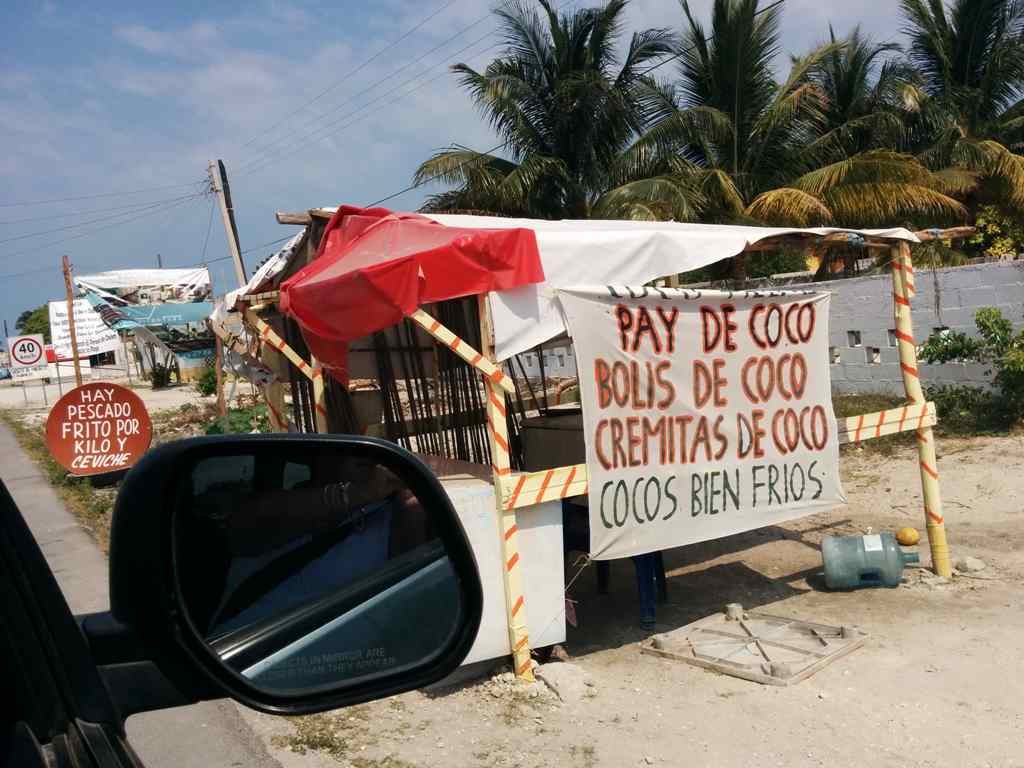
Much of what you see as Street food along the Gulf in villages like Chuburna and Progreso will be coconut based, as this is the traditional means of earning primary or secondary income for many local families.
The coconuts are harvested all year round and for the most part, landowners allow the gathers to collect the coconuts free of charge from their land. It is an exchange that benefits both as coconuts when ripe can cause a great deal of damage when they fall to both people and property. The collectors generally come into your property, harvest the ripe coconuts and take away all the coconut tree debris and branches that need to be trimmed and cleaned up. Most homeowners offer the workers refrescos or a little propina (tip) to buy some Coke with when they are finished harvesting.
The main items you will see on the roadsides are Coco de Pays (coconut custard pie), Coco Flan, Coco Frio (cold coconut water), Cremitas de Coco, and Bolitos de Coco and Coco Paletas (a coconut popsicle).
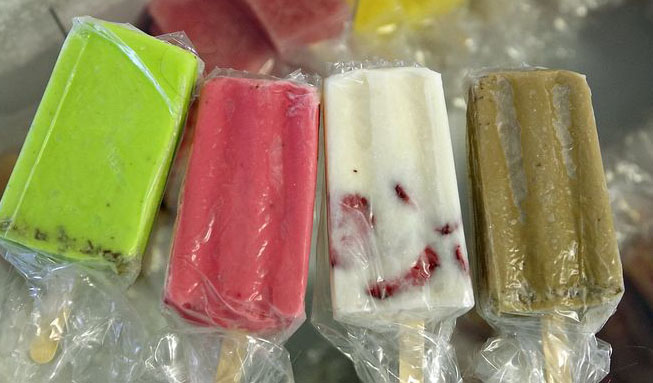
Pay de Coco
For Rick Bayless who first tasted Pay de Coco in the Yucatan, it has become a real treat. Traditionally made with sweetened condensed milk the pie is dense and chewy, rich with freshly grated coconut. It stays fresh for a few days and is not a fragile pie. You can find an adapted recipe on the Rick Bayless website.
Cremitas de Cocos
Cremitas de Cocos is a popular dessert here in Yucatan, very similar to a flan, the coconut is thickened with cornstarch and eggs into a simple pudding, which costs around 10 pesos. You will find an excellent recipe here on the Locogringo Blog
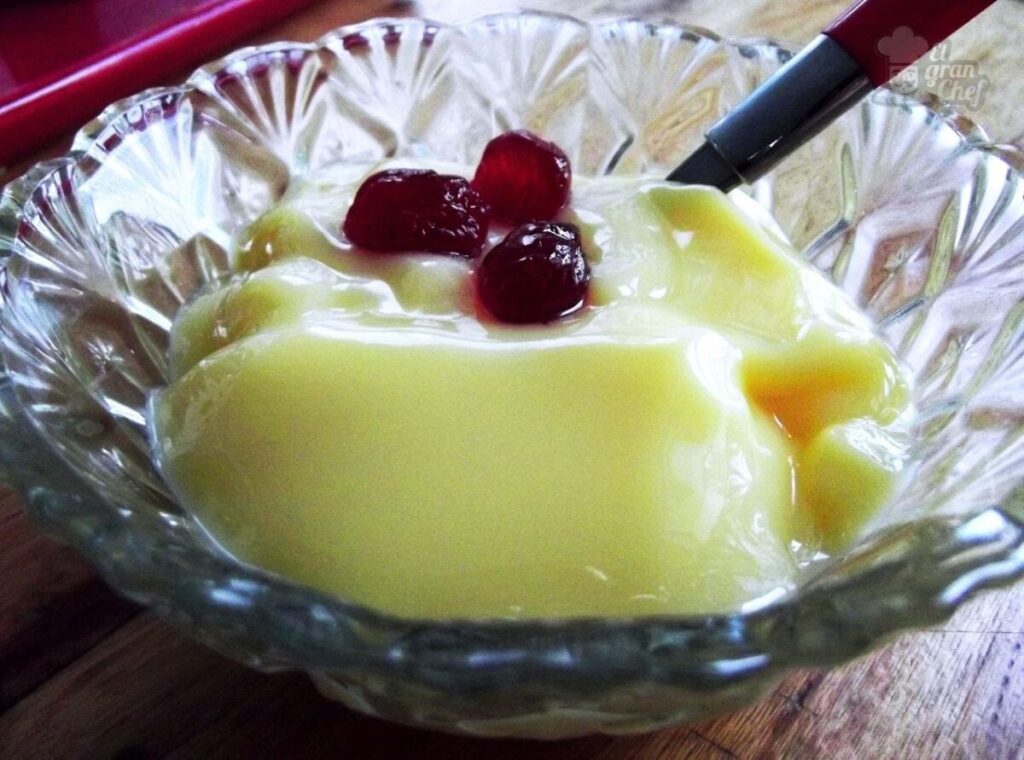
Coco Frios
Coco Frios are lovely green coconuts with the top chopped off and a straw stuck in to get at the delicious and incredibly healthy coconut water.

Bolitos de Coco con Camote
Bolitos de Coco con Camote are little round balls of sweet potato flavoured with Mexican honey or sugar and cinnamon. The mixture is formed into a ball and then rolled into freshly grated coconut.
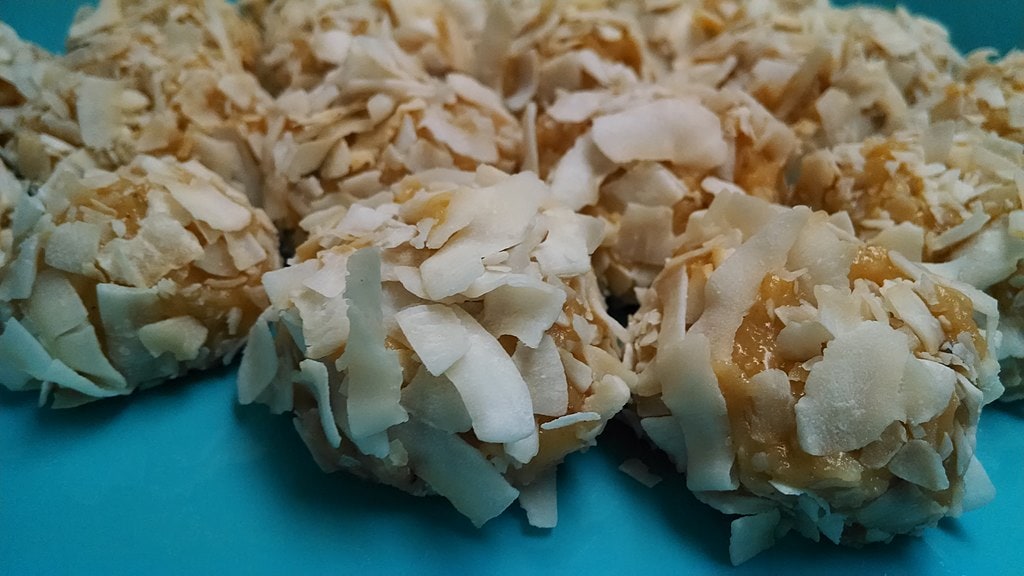
Raspados
Raspados are found all over Mexico and they are essentially a snow cone, but with one significant difference, the origin of the verb raspar means “to scrape” and the best raspados are hand scraped from a huge chunk of ice. The raspado is then flavoured with fruit syrups, a pinch of salt and a drench of condensed milk and chamoy if requested. A sweet, cold treat for the hot summer months raspados come in a variety of flavours from coconut to mamoy, pineapple and many more.
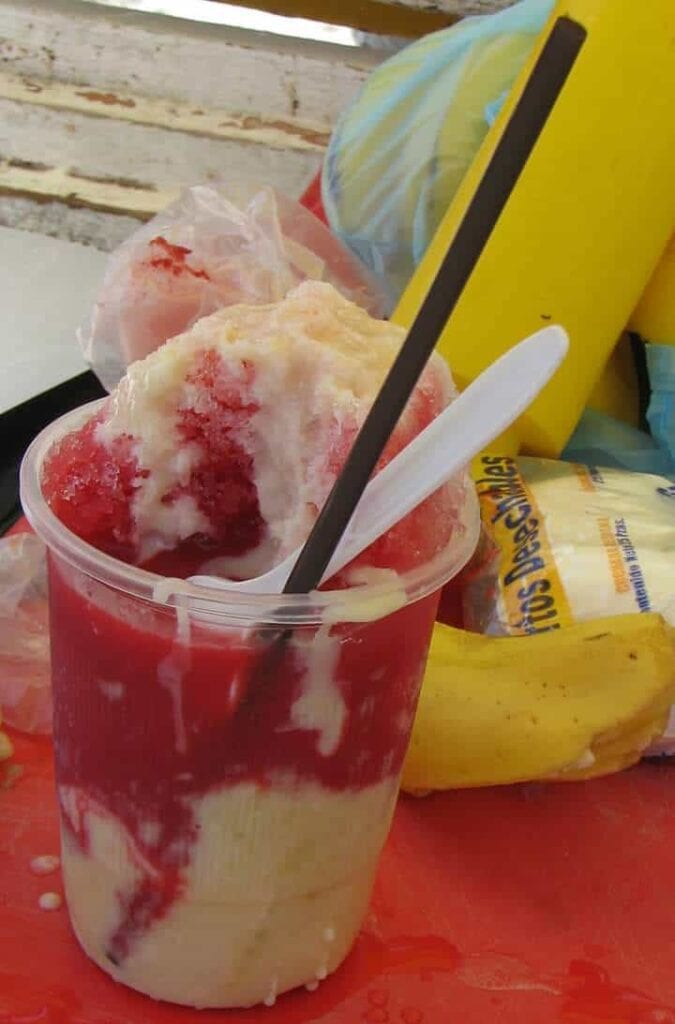
Paletas
Paletas in the Yucatan are a cool Mexican popsicle treat. Made from fresh fruits and fruit juices the combinations are endless but at the roadside stalls, the main flavour is coconut.
An old Mexican legend says that the Aztec emperors had servants who would bring ice from the volcano, outside Mexico City. The emperors would eat this ice, mixed with fruits.

In the 1940s, one of the most famous Mexican heladerías opened for business — La Michoacana. Typical flavours include watermelon, lime, mamey, mango, coconut, and pineapple with chilli powder, cucumber with chilli powder, pecan, pistachio or tamarind. Sometimes they are covered with chocolate or nuts, and sometimes they have layers of different flavours.
Mexican street food in the Yucatan does include the familiar tacos, tortillas, and tortas but it also includes some items that are uniquely Yucatecan.
Marquesitas
are something that you find made all over Merida and it is a favourite treat for kids and adults alike. This is a crepe that is rolled up around a variety of fillings from blackberry jam, to the real speciality that is queso and caramel sauce or Nutella. Invented in Merida in 1938 these crepes became the favourite snack of the daughters of a Marquis living in the City so much so that they became named the marquesita after the little girls.

Merenque
Merenque, merenque” is a call you will hear very frequently on the beaches of the Yucatan, pastel coloured Italian meringue whipped by hand is piped out onto paper-covered tables, and then baked from above by placing red-hot coals atop a large steel drum that covers the merengues. The merenque is also shaped into a spiral and a stick placed on one end for a children’s treat, these merengues are usually brightly coloured.

Want to get out of the ice and snow in N. America? Here’s how to retire to Mexico
Kibis
As you pass through rural areas and fishing villages (as well as in Mérida) you will often see handwritten signs advertising kibis it may seem strange to see this Middle Eastern treat here in the Yucatan but there is a large Lebanese immigrant community that has made these little stuffed treats a great street food snack.

Kibis are made from roughly ground wheat kernels (similar to bulgur). They are football-shaped and then deep fried, once they come out of the oil they are then stuffed with fillings that include; meat, cheese, cabbage, habaneros and onions.
Panuchos
A panucho starts with a tortilla that has been warmed split and stuffed with refried beans, the tortilla is then fried and finally topped with meat, sour orange pickled onions, and sometimes lettuce or cabbage along with avocado and sliced tomato.
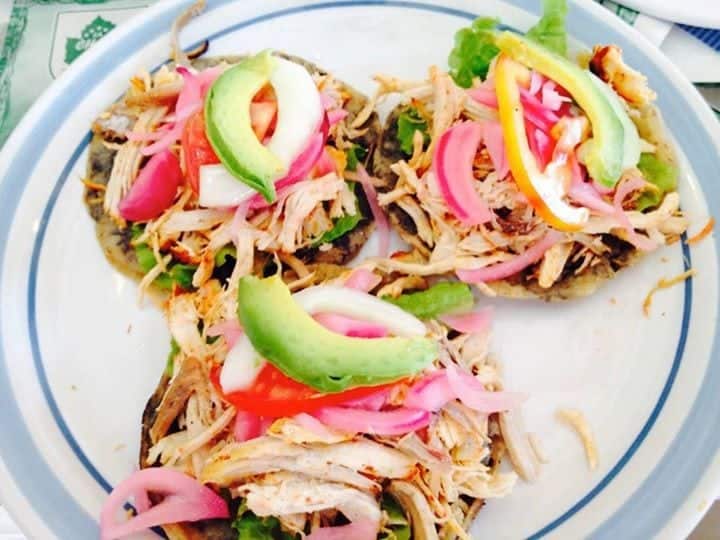
Quesadilla
The Mexican version of grilled cheese sandwich, a quesadilla can be either a flour or corn tortilla folded and then cooked in a pan until the cheese melts. In Mexico, Oaxaca cheese is used but in North America we use mozzarella.
Salbutes
The salbute is similar but the tortilla is simply fried and then topped with everything but refried beans.
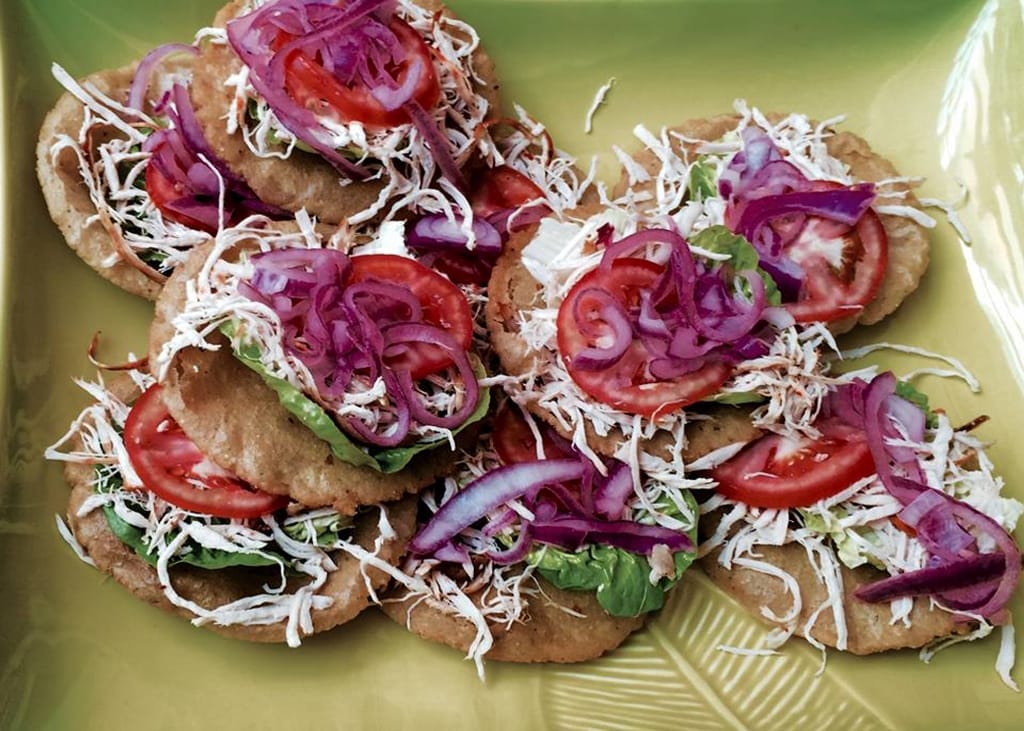
Want to live in the Yucatan – here are some great tips for living on the gulf coast.
Tostada
Tostadas are a traditional Mexican street food of corn tortillas that are fried till crispy and then topped with pretty much everything you can imagine.

Elotes
Elote’s are a Mexican street corn treat that consists of grilled corn on the cob that is then dressed with a lime-flavoured crema (mayonnaise), dipped in cotijo or queso fresco (which is cheese) and then sprinkled with chilli pepper. Unlike North American sweet corn on the cob, Mexican corn has a solid very starchy and sweet kernel. These are sold by street vendors all over Mexico but it is considered a particular Yucatan treat.
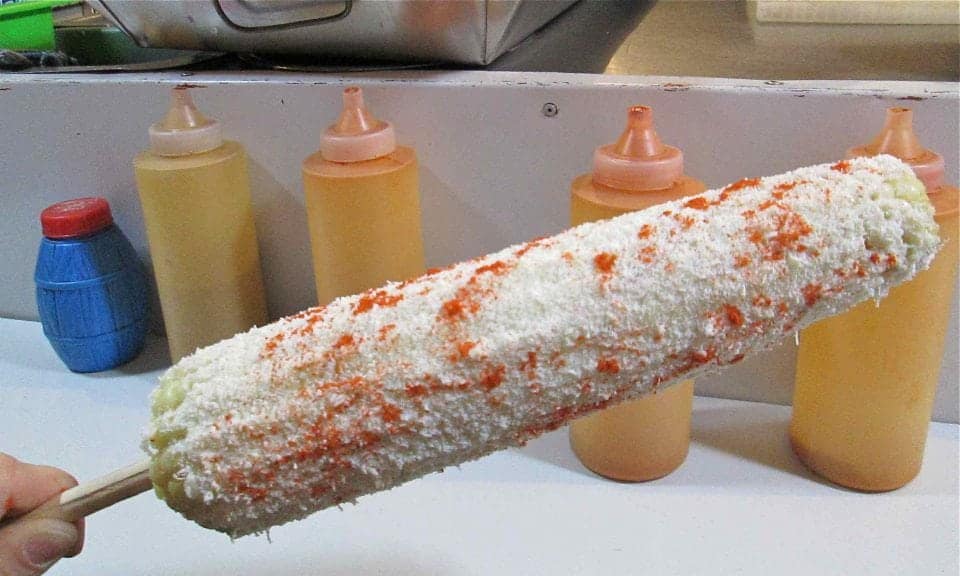
Esquites
Esquites are from the same corn but removed from the cob and served in a cup.
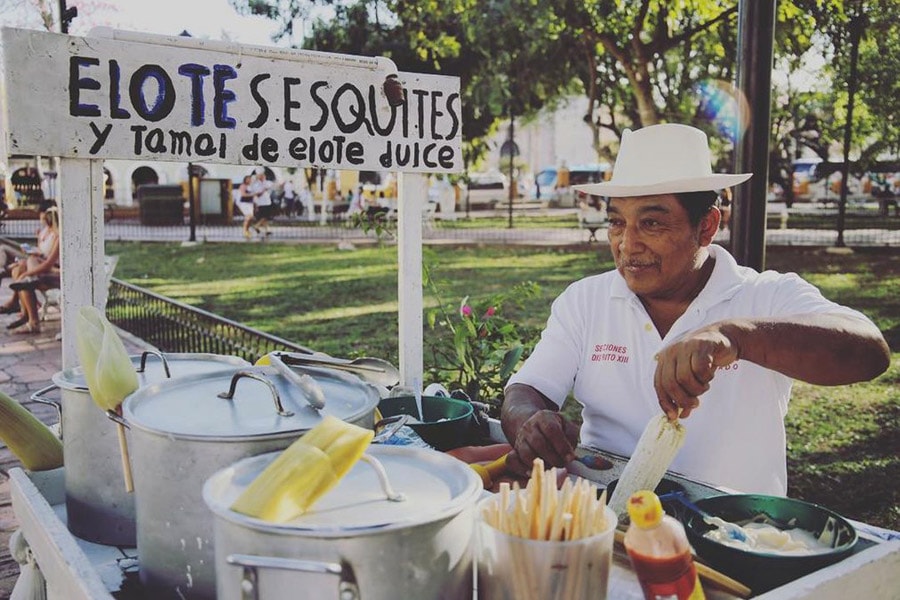
Tamales
Mexican tamales vary from region to region and everyone loves a tamale but here in the Yucatan tamales are a rare thing to find as street food. They are a labour-intensive dish that you may find at some of the markets in the area and consider yourself lucky if you do find some to buy. If you get the chance take a cooking class to learn how to make them.
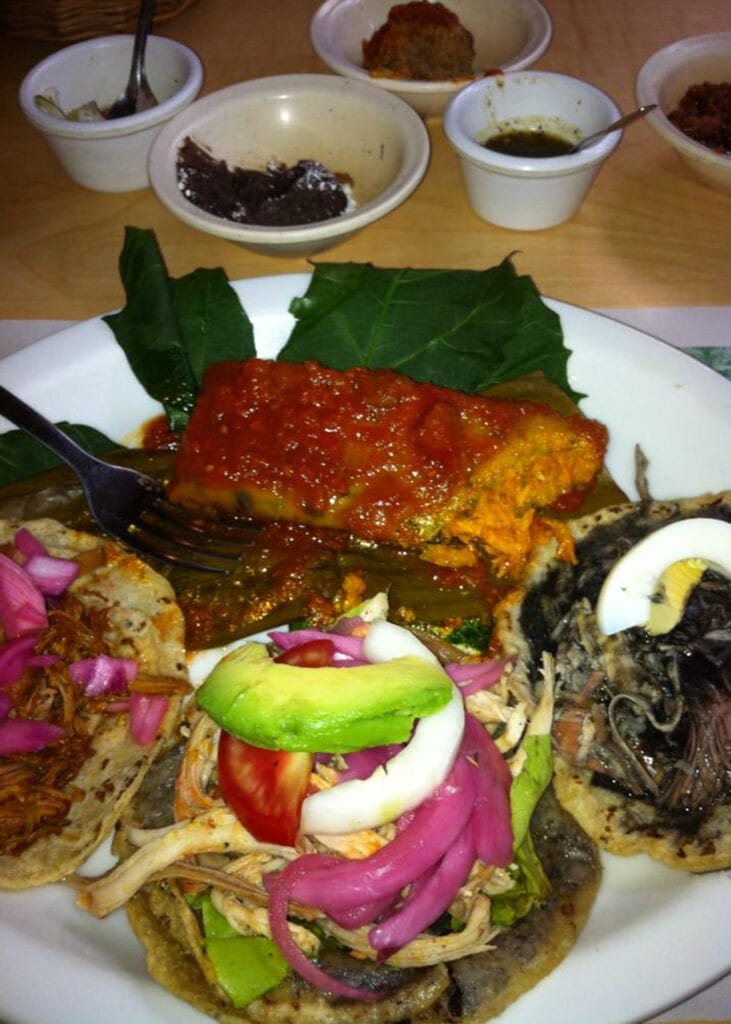
In the Yucatan Mayan tamale recipes call for the tamale to be wrapped in a banana leaf, whereas in the rest of Mexico they are wrapped in corn husks.
Gordita and sopas
A sope is a thick corn tortilla topped with beans, cheese, salsa and shredded pork, chicken or whatever you request. A gordita is a Spanish word that means fat little girl and it is a thick tortilla but it can be split (like a pita) with ingredients like shredded port, cheese, and beans added to the centre of the masa before it is cooked.
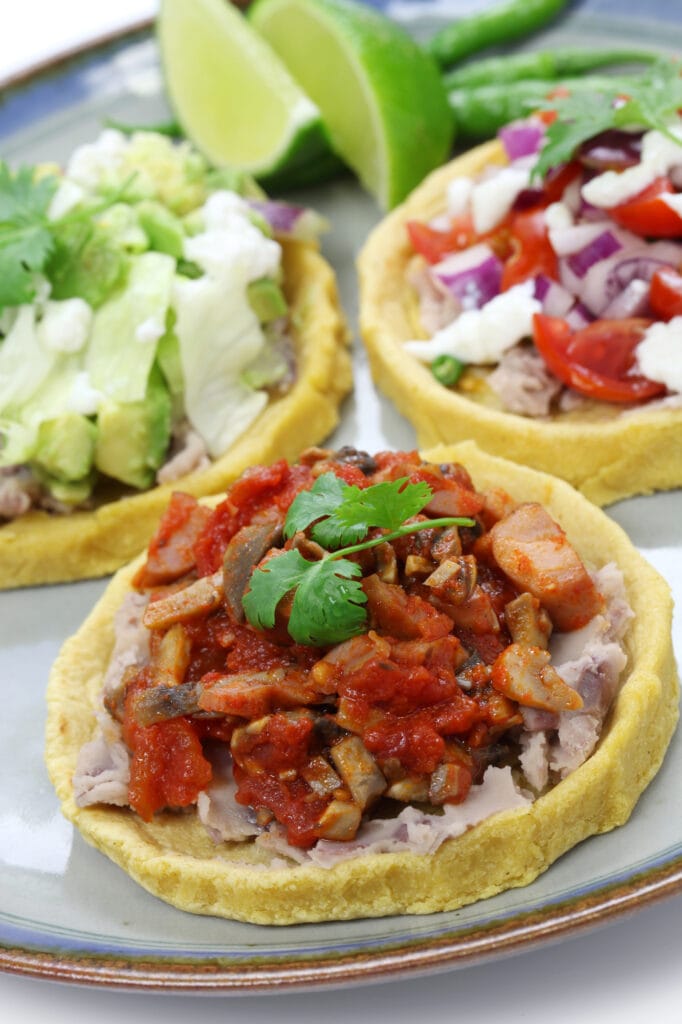
The tlacoyo is also very similar—it’s made in Mexico City and will usually be made of blue corn. All of these corn treats can be found at street stalls throughout the country but the names and fillings/toppings may vary from place to place.
Tacos
The quintessential Mexican street food is of course the taco. In Mexico, you will find tacos of every variety- carnitas, barbacoa, al pastor, adobada, seafood, and countless other variations. The ancient word is from the Nahuatl “tlahco,” and it simply refers to something folded. Tacos were made from cattle corn kernels that are nixtamalized with an alkaline treatment to remove the husk and then ground into fine corn flour. Historians date the first traces of nixtamalized corn back to the Olmec culture back in 1,500 BC.
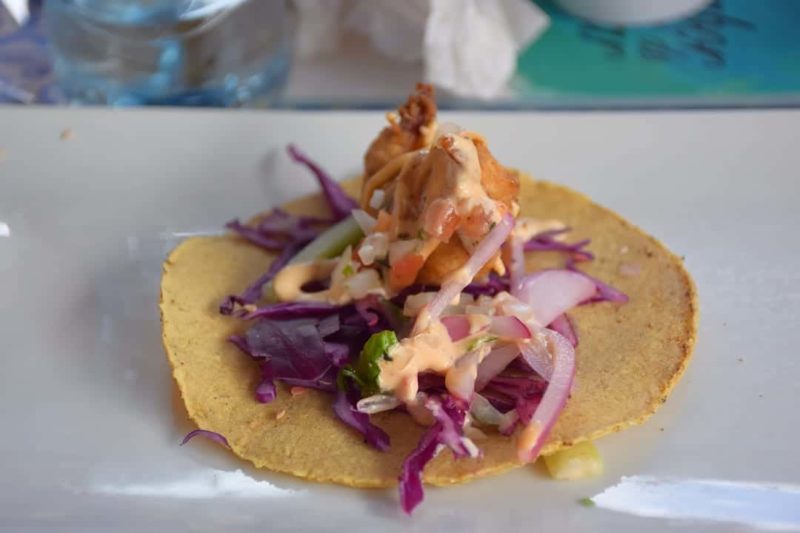
Tacos al pastor are one of the most popular varieties of taco and they were born from Lebanese immigrants to Mexico to resemble shawarma.
Corn tortillas are seen as more authentic, however, because corn has been a staple ingredient in Mexican cuisine for thousands of years.
Torta Cubana
Despite the name a Torta Cubana is a Mexican Sandwich that was probably invented in Mexico City. The Torta is filled with a wide variety of meats including items such as: hot dogs, pulled pork, pork loin, ham, chorizo, cheese, and various vegetables. all beautifully stuffed in a crusty bolillo or telera bun.
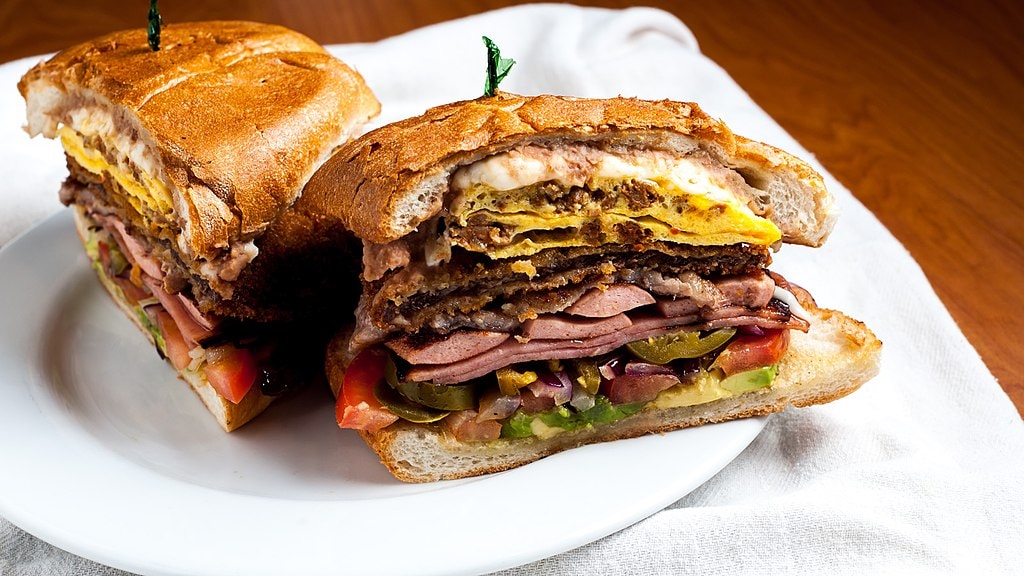
Cemitas, Tortas, Empalme and Pambazos
A torta is a Mexican snack which North Americans call a Mexican sandwich but it isn’t called a sandwich in Mexico because for a Mexican a sandwich is something that is made with sliced bread. The torta is made on a crusty bun called a bolillo rather like a French baguette but smaller and will have fillings such as meat, tomato, jalapenos, avocado, and refried beans each side of the bun can have a different spread usually mayonnaise on one side and butter on the other. The torta is then either media ahogada (“half drowned” or partially dipped) or bien ahogada (“well drowned”) in spicy salsa.
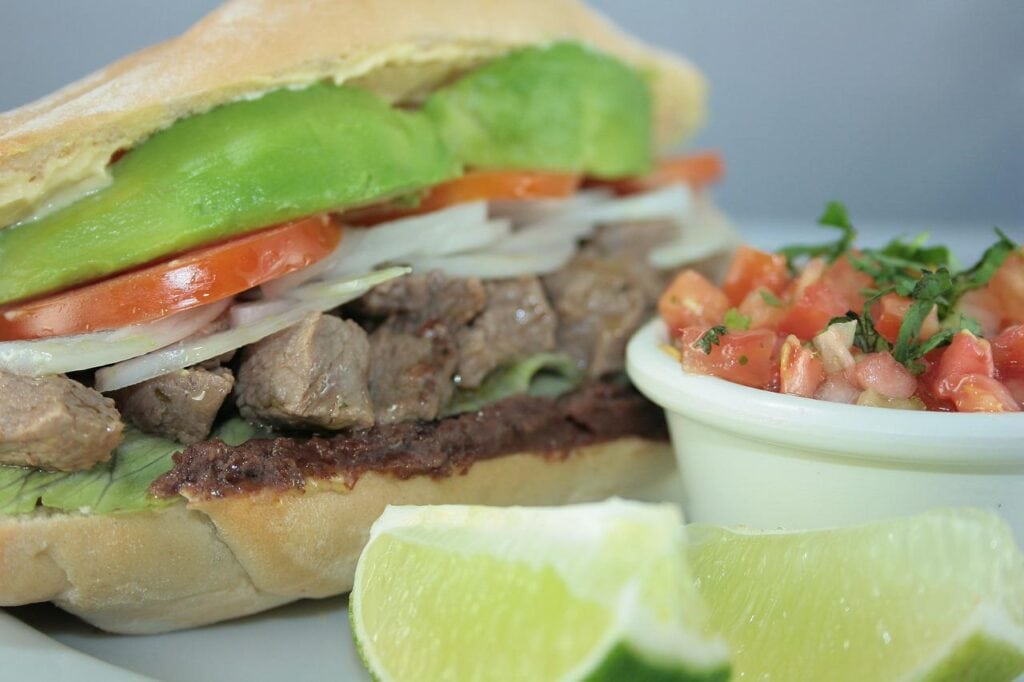
A cemita is made with different bread to a torta which is soft and round and the herb papalo is added to the toppings. Papalo is green similar to arugula with a cilantro flavour. Pambazos, are a version of a cemita with chorizo and potato then dipped in guajillo chile sauce and friend.
An Empalme is a type of Mexican sandwich that is particular to certain areas of Mexico, and generally is made from corn flour tortillas. This dish commonly includes refried beans and salsa, as well as pork fat. Other filling ingredients may also be added to create different flavor profiles or specialty versions of the dish.
Tlacoyos
A widely enjoyed morning meal in Mexico City is the tlacoyo, a humble bite discovered on every block. Despite being crafted with corn masa (dough) similar to the commonly seen taco, tlacoyos possess a unique quality.
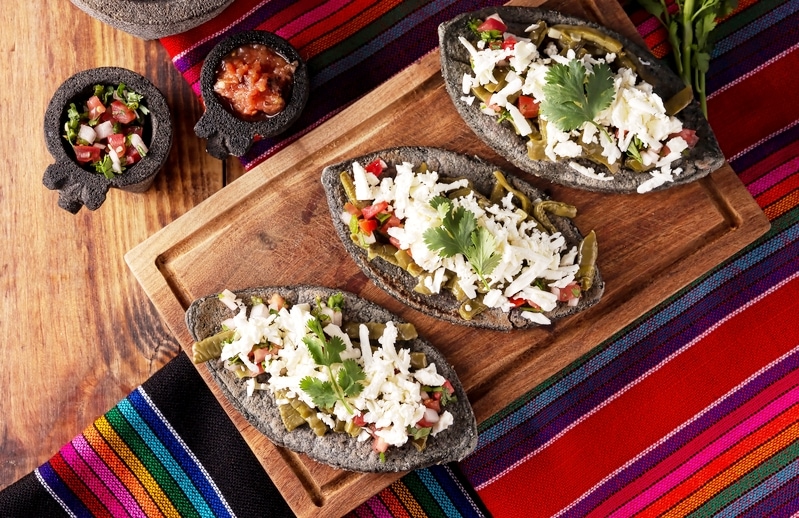
These elongated snacks are filled with a variety of beloved Mexican ingredients such as cheese, beans, and potato. Additionally, they are garnished with salsas, salad, and cactus, making them even more delicious. It’s no surprise that tlacoyos are widely enjoyed in Mexico City.
Street food in Mexico I consider some of the best in the world and the variety can seem endless. You can walk a Mexican market munching on deep-fried grasshoppers, drink a horchata or stop for some of that famous Mexican tequila.
Whatever you choose for your street food in Mexico be it gorditas, quesadillas, empalmes, tostadas, chalupa, tlayudas, cemita, pambazo, empanada, nachos, fajita and tortas, or one of the many unusual Mexican fruits I have no doubt you will return again to enjoy the many choices you will find.
